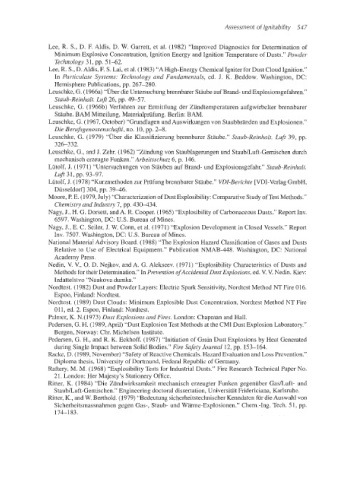Page 580 - Dust Explosions in the Process Industries
P. 580
Assessment of lgnitability 547
Lee, R. S., D. E Aldis, D. W. Garrett, et al. (1982) “Improved Diagnostics for Determination of
Minimum Explosive Concentration, Ignition Energy and Ignition Temperature of Dusts.” Powder
Technology 31, pp. 51-62.
Lee, R. S., D. Aldis, F. S. Lai, et al. (1983) “A High-Energy Chemical Igniter for Dust Cloud Ignition.”
In Particulate Systems: Technology and Fundamentals, ed. J. K. Beddow. Washington, DC:
Hemisphere Publications, pp. 267-280.
Leuscbke, G. (19664 “mer die Untersuchung brennbarer Staube auf Brand-und Explosionsgefahren.”
Staub-Reinhalt. Luft 26, pp. 49-57.
Leuschke, G. (1966b) Verfahren zur Ermittlung der Zundtemperaturen aufgwirbelter brennbarer
Staube. BAM Mitteilung, Materialpriifung. Berlin: BAM.
Leuschke, G. (1967, October) “Grundlagen und Auswirkungen von Staubbranden und Explosionen.”
Die Berufsgenossenschafti, no. 10,pp. 2-8.
Leuschke, 6. (1979) “Uber die Klassifizierung brennbarer Staube.” Staub-Reinhalt. Luft 39, pp.
326-332.
Leuschke, G., and J. Zehr. (1962) “Zundung von Staublagerungen und StaubrZuft-Gemischen durch
rnechanisch erzeugte Funken.” Arbeitsschutz 6, p. 146.
Liitolf, J. (197 1) “Untersuchungen von Stauben auf Brand- und Explosionsgefahr.” Staub-Reinhalt.
Lllfi 31, pp. 93-97.
Liitolf, J. (1978) “Kurzmethoden zur Priifung brennbarer Staube.” VDI-Berichfe [VDI-VerlagGmbH,
Dusseldorfl 304, pp. 39-46.
Moore, P. E. (1979,July) “Characterization of Dust Explosibility:Comparative Study of Test Methods.”
Chemisty and Industry 7, pp. 430434.
Nagy, J., H. 6.Dorsett, and A. R. Cooper. (1965) “Explosibility of Carbonaceous Dusts.” Report Inv.
6597. Washington, DC: U.S. Bureau of Mines.
Nagy, J., E. C. Seiler, J. W. Conn, et al. (1971) “Explosion Development in Closed Vessels.” Report
Inv. 7507. Washington, DC: U.S. Bureau of Mines.
National Material Advisory Board. (1988) “The Explosion Hazard Classification of Gases and Dusts
Relative to Use of Electrical Equipment.” Publication NMAB-448. Washington, DC: National
Academy Press.
Nedin, V. V.. 0. D. Nejkov, and A. G. Alekseev. (1971) “Explosibility Characteristics of Dusts and
Methods for their Detennination.”In Prevention ofAccidental Dust Explosions,ed. V. V. Nedin. Kiev:
Izdattelstvo “Naukova dumka.”
Nordtest. (1982) Dust and Powder Layers: Electric Spark Sensitivity, Nordtest Method NT Fire 016.
Espoo, Finland: Nordtest.
Nordtest. (1989) Dust Clouds: Minimum Explosible Dust Concentration, Nordtest Method NT Fire
011, ed. 2. Espoo, Finland: Nordtest.
Palmer, IC. N.(1973) Dust Explosions and Fires. London: Chapman and Hall.
Pedersen, G. H. (1989, April) “Dust Explosion Test Methods at the CMI Dust Explosion Laboratory.”
Bergen, Norway: Chr. Michelsen Institute.
Pedersen, G. H., and R. K. Eckhoff. (1987) “Initiation of Grain Dust Explosions by Heat Generated
during Single Impact between Solid Bodies.” Fire Safety Journal 12, pp. 153-164.
Racke, D. (1989, November) “Safety of Reactive Chemicals. Hazard Evaluation and Loss Prevention.”
Diploma thesis, University of Dortmund, Federal Republic of Germany.
Raftery, M. M. (1968) “Explosibility Tests for Industrial Dusts.” Fire Research Technical Paper No.
21. London: Her Majesty’s Stationery Office.
Ktter, K. (1984) “Die Ztindwirksamkeit mechanisch erzeugter Funken gegenuber GasLuft- und
Staubkuft-Gemkchen.” Engineering doctoral dissertation, Universitat Fridericiana, Karlsmhe.
Ritter, K., and W. Berthold. (1979) “Bedeutung sicherheitstechnischerKenndaten fur die Auswahl von
Sicherheitsrnassnahmen gegen Gas-, Staub- und Wme-Explosionen.” Chem.-Ing. Tech. 5 1, pp.
174-1 83.

